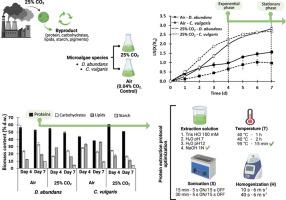二氧化碳对两种高产绿色微藻生物量组成的调节,作为一种可持续的副产品生成系统
IF 3.8
Q2 BIOTECHNOLOGY & APPLIED MICROBIOLOGY
引用次数: 0
摘要
微藻有可能减少大气中的二氧化碳并产生可持续的副产品。然而,CO2如何影响不同物种的碳通量尚不清楚。本研究评价了工业废气CO2浓度对丰富桥连菌和普通小球藻生长和生化组成的影响。供气(CO2/空气浓度为25% v/v)可促进两种植物的生长(D. abundance和C. vulgaris分别为1.38±0.02 g L−1和1.56±0.02 g L−1)。在高CO2环境下,蛋白质是主要的代谢产物,特别是对普通C. vulgaris,而D. abundance没有变化(分别为51±0和49±3%)。两种植物的碳水化合物和淀粉含量在空气条件下均高出1.2 ~ 2.2倍。此外,在空气条件下,C. vulgaris的脂质增加了2 ~ 3倍,而D. abundance在高CO2条件下呈指数增长。然而,由于高CO2条件下生物量产量最佳,所有代谢物浓度在CO2浓度为25%时最高。有趣的是,D. abundance在高CO2下的色素含量高出2 - 3倍,表明其对高CO2的适应存在差异。最后,优化了一种快速且具有成本效益的蛋白质提取方案(95°C, 15 min, NaOH 1N),其在指数生长期间的产率与标准微凯氏定氮法相当,在固定相时产率有所变化(80 - 89%)。高二氧化碳的影响是物种特异性的,其中丰度菌是一个健壮的物种。进一步的研究应评估潜在应用的蛋白质提取物的性质,并考虑系统扩大的技术、经济和环境可行性。本文章由计算机程序翻译,如有差异,请以英文原文为准。

Modulation of biomass composition by CO2 in two highly productive green microalgae as a sustainable system for byproduct generation
Microalgae have the potential to mitigate atmospheric CO2 and generate sustainable byproducts. However, how CO2 impacts C-flux in different species is not clear. This study evaluated the effect of CO2 concentration from industry exhaust gas on growth and biochemical composition of Desmodesmus abundans and Chlorella vulgaris. Gas supply (25 % v/v CO2/air) stimulated growth of both species (1.38 ± 0.02 and 1.56 ± 0.02 g L−1 for D. abundans and C. vulgaris, respectively). Proteins were the major metabolite at high CO2, especially for C. vulgaris, while D. abundans showed no variation (51 ± 0 and 49 ± 3 % d.w., respectively). Both species exhibited 1.2–2.2-fold higher carbohydrate and starch content under air. Also, under air, C. vulgaris showed an increase of 2 to 3-fold in lipids, contrary to D. abundans that increased under high CO2 during exponential growth. However, as biomass production was optimal at high CO2, all metabolite concentrations were highest at 25 % CO2. Interestingly, D. abundans exhibited 2 to 3-fold higher pigment content under high CO2, suggesting a differential adaptation to high CO2. Lastly, a rapid and cost-effective protein extraction protocol was optimized (95 °C, 15 min, NaOH 1N) with comparable yields to the standard Micro-Kjeldahl method during exponential growth and some variation at stationary phase (80–89 % yield). The effect of high CO2 was species-specific, where D. abundans appears as a robust species. Further studies should evaluate the nature of the protein extract for potential applications and consider technical, economic, and environmental feasibility for system scale-up.
求助全文
通过发布文献求助,成功后即可免费获取论文全文。
去求助
来源期刊

Biocatalysis and agricultural biotechnology
Agricultural and Biological Sciences-Agronomy and Crop Science
CiteScore
7.70
自引率
2.50%
发文量
308
审稿时长
48 days
期刊介绍:
Biocatalysis and Agricultural Biotechnology is the official journal of the International Society of Biocatalysis and Agricultural Biotechnology (ISBAB). The journal publishes high quality articles especially in the science and technology of biocatalysis, bioprocesses, agricultural biotechnology, biomedical biotechnology, and, if appropriate, from other related areas of biotechnology. The journal will publish peer-reviewed basic and applied research papers, authoritative reviews, and feature articles. The scope of the journal encompasses the research, industrial, and commercial aspects of biotechnology, including the areas of: biocatalysis; bioprocesses; food and agriculture; genetic engineering; molecular biology; healthcare and pharmaceuticals; biofuels; genomics; nanotechnology; environment and biodiversity; and bioremediation.
 求助内容:
求助内容: 应助结果提醒方式:
应助结果提醒方式:


